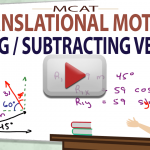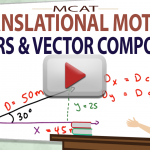As an MCAT tutor, one of the common questions I receive is “How do I know which equations to use?” With so many formulas to memorize it’s hard to keep them all straight, and even harder to pick out one from the many many formuals you’ve studied. The video below breaks down the different kinematic […]
Projectile Motion in MCAT Kinematics Translational Motion Video 8
Projectile motion questions are an interesting phenomenon in your MCAT Physics preparations. Think back to your general physics course, if you had to solve a projectile motions question you likely found yourself spending 20-30 minutes on a question complete with 3-4 unique calculations. However, you won’t have the leisure of time on your MCAT. And […]
Free Fall in MCAT Kinematics Translational Motion Video 7
Free fall is a specific application of acceleration and kinematics, where gravity is the only form of acceleration in a given problem. These questions include objects being thrown up, or objects falling down without any applied acceleration. The video below helps you understand the nature of Free Fall as it will show up on your […]
Acceleration in MCAT Physics Translational Motion Video 6
Acceleration, that tricky little concept that shows up in just about every physics question. From the applied acceleration in kinematics, to the implied acceleration of gravity, this topic will show up again and again in your MCAT practice. With multiple related equations, it’s important that you have a proper understanding of this not-so-intuitive concepts in […]
Velocity and Speed in MCAT Translational Motion Video 5
One of the most critical concepts you will cover in preparation for your MCAT is the topic of velocity, often confused with ‘speed’. Velocity questions may be disguised in any of the topics covered later on, from simple accelerate to circuits, waves and optics. The video below gives you a quick overview of the difference […]
Adding Two Dimensional MCAT Vectors Using Angles and Vector Components Translational Motion Video 4
This video picks up from Part 3 where we discussed adding and subtracting vectors when facing in the same and opposite directions. But the MCAT is designed to be tricky, and so you will likely find yourself faced with a problem combining vectors at some odd angle off the x-axis or y-axis. This video shows […]
Vectors and Vector Components in MCAT Translational Motion Video 2
As you are reviewing your general physics concepts for the MCAT you will come across practice questions utilizing 1, 2, or 3 dimensions. While the MCAT only tests on single and two-dimensional problems, you will often find yourself faced with a vector situated between the x and y axis. However, some of the required calculations, […]
Introduction to Translational Motion in MCAT Physics
The topic of translational motion and standard kinematics may very well be one of the most important concepts to cover in your MCAT physical sciences preparations. As you work through the different topics in physics you will find yourself returning to these equations again and again. Given how important this is, I recommend that you […]
Tollens Reagent Silver Mirror Test for Aldehydes
The Tollens Test for Aldehydes, also known as the Silver Mirror Test, is a great way to confirm if an unknown carbonyl is an aldehyde or not. This occurs by reacting the unknown carbonyl with Silver +1 which gets reduced to metallic silver (Ag 0) when the aldehyde is oxidized to a carboxylic acid. This […]
How She Scored a 518 on Her MCAT
The MCAT is a grueling 7.5 hour exam and should not be approached lightly. However, hearing that you need to devote ~500 hours over 6-8 months can sound overwhelming if you’re just getting started. Many struggle, and many many students postpone and retake. But… this is typically due to inadequate preparation or unpredictable circumstances. If […]
- « Previous Page
- 1
- …
- 22
- 23
- 24
- 25
- 26
- …
- 47
- Next Page »












